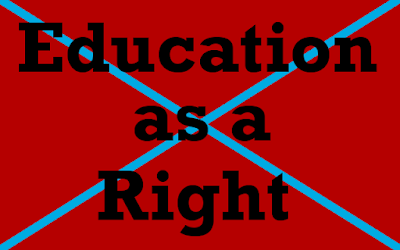 |
| LS, Education as a Right. 2015 |
Education as a Human Right
Often, people don’t realize that children are the future of the world. Many parent don't see that they’re creating the next presidents, lawyers, doctors, and political leaders. If we hope to have a successful future and world, then we need to come together and make a plan so that all our children are educated. I believe ability to be able to to complete a primary education should be a human right.
Children are our future. If our children are uneducated, then the future of the world may be in danger. The Maslow's Hierarchy of needs goes in this order in levels: Physiological, Safety, Love/Belonging, Esteem, Self-Actualization. Under this hierarchy of needs, the need for education is apart of achieving the Self-Actualization level. This need isn’t needed for survival as an individual, but rather the survival of an economy or a culture. “The price of education is the cost of competitiveness in tomorrow’s economy, and it is in all Americans’ enlightened self-interest to invest in our future.” (Albada, Michael) What the author is trying to explain is that if we don’t invest in our children’s education now, we’re failing to invest in the future.
Making sure every child around the world is educated can benefit the growth and development of the human race as a whole. If education didn’t exist, we wouldn't be able to innovate and develop to grow and fit the rising need of new and better technology and goods. If we aren’t able to fulfill the need of new things, the economy will fall. Thus, the entire economic system is based on education. ”Additionally, in today’s increasingly global economy, education is becoming a necessary component for innovation, growth and development.” (Albada, Michael) In this quote, the writer explains the need of education in order to expand as a human race.
The most obvious solution to the problem of children not receiving primary education is to make it a human right. Making primary education a human right would force countries to give their children an education. Education is a fundamental human right and essential for the exercise of all other human rights. When we introduce problems lightly, action is hardly ever taken. Countries need to understand the importance of education and how it contributes to their future. In order for the proper schooling to be available, a global fund must be created and certain countries must pay varying amount based on their income to contribute to worldwide free and accessible primary education.
Free primary education should be a human right because it directly contributes to the future of certain countries and the development of the human race as a whole. I believe ability to be able to to complete a primary education should be a human right.If we can make this a right and force people to educate our children, we can ensure a good future for the world.
Works Cited
Albada, Michael. "Stanford Progressive." The Stanford Progressive. 1 Mar. 2010. Web. 16 Sept. 2015.
The Right to Education." The Right to Education | Education | United Nations Educational, Scientific and Cultural Organization. Web. 17 Sept. 2015.
